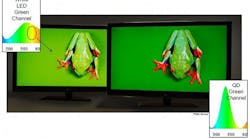This file type includes high-resolution graphics and schematics when applicable.
For many years, consumers were accustomed to just one type of electronic display—the cathode-ray tube (CRT), used in television sets virtually since the invention of TV. These displays, while heavy and clunky, continued to be employed well into the 1990s, when we began to transition to newer, lighter and slimmer options such as liquid-crystal displays (LCDs). Outside of a brief flirtation with plasma, consumers embraced LCDs for TVs, and the technology currently represents more than 90% of the market.
That said, nothing is perfect—this applies both to LCD technology and to organic LED (OLED), which emerged within the last decade as an alternative to LCD. Each application has advantages and shortcomings that impact its suitability for use in TVs and other display applications. And then there are quantum dots. If you haven’t yet heard much about them, you soon will.
The key disadvantage associated with LCDs is color gamut, or how well it represents various colors in an image. In an LCD, light is processed through a stack of materials—transparent, conductive coated glass; color filters; diffusers; polarizers, etc.—and is significantly diminished by having to travel through all of these layers. The light source doesn’t possess the necessary color gamut, and passing through the layers makes it worse. The industry has long worked around this known issue, but has continued to seek ways to mitigate it, including changing the source of light (backlight) from fluorescent lamps to LED. There’s also ongoing effort to configure these LED backlights so that they improve the quality of light being emitted.
OLEDs, on the other hand, deliver higher color quality and saturation than LCDs. However, manufacturing large OLED substrates poses process and technology complexities that make it difficult to achieve high yields, thereby rendering them very expensive. Consequently, while OLED is being used successfully in products with smaller form factors, few companies are making OLED TVs.
QDs Boost LCDs
How to bridge the gap? Quantum dots (QDs). These semiconductor nanocrystal particles are used to enhance LCD backlighting, rendering as much as a 30% increase in the visible spectrum. Light from the LCD backlight is channeled through the quantum dots, resulting in more vivid colors and an improved color gamut.
The figure shows the vibrant colors produced by QDs. LCDs married with QDs deliver color richness, quality, and contrast similar to that of OLED, but at a fraction of the price. Consensus among market researchers is that, starting this year, the global QD market is expected to grow by about $1 billion per year over the next decade.
Several methods can be used to make QD-LCDs, including attaching the dots to a sheet of film inserted into the material stack, or placing a narrow tube containing the QDs in front of the LED backlight. In fact, both of these techniques have been used to mass-produce QD-LCDs in the recent past.
QD Vision Inc. is spearheading the tube approach, while Nanosys Inc. is focused on the QD film technology—both are partnering with a number of companies in the TV and display monitor market. On the other hand, industry giant Samsung, which has abandoned OLED for TVs and fully endorsed QD, is pursuing a third approach: directly applying the quantum dots to the backlight source.
One downside of QD technology has been the use of heavy metals, such as cadmium, to create the dots. These heavy metals are increasingly being restricted around the world. On that front, companies such as Quantum Materials Corp. and Nanoco Technologies are pursuing other means of creating quantum dots that do not contain heavy metals.
Very few nanocrystal quantum dots are required per TV—about a gram of material is adequate—which makes them less expensive. Moreover, quantum dots are suitable for numerous other, diverse applications, including solar cells, solid-state lighting, biotechnology, and security, to name a few.
So, will quantum dots kill OLED? Not at this time. Their advantages, including the ability to make them flexible and curved, make them well-suited for smaller-form-factor products such as wearable devices and mobile phones. The technology is strongly positioned in this sector, thanks to the curved screens increasingly being designed into mobile devices, which can’t easily be made using glass-based LCDs.
Quantum dots, however, give LCD the opportunity to continue its domination of the market for applications such as signage, monitors, and TV. In the end, while vivid colors are highly desirable, cost tends to trump in consumer markets, and quantum dots enable the well-depreciated LCD factories to keep the high end of the TV market from moving to OLEDs. In the future, quantum dots will be combined with OLEDs, making them even better! In the next several months, I predict that quantum dots will become part of your vocabulary, made popular by various TV brands worldwide.
Quantum Dots at Display Week
Given their up-and-coming status, quantum dots will be a hot topic at the Display Week conference, running until May 27. Presentations and panels will examine QD, as well as OLED technology, with experts from companies and universities all over the world providing a glimpse of what they’re working on in these areas. To learn more, please mark your calendar and join us in San Francisco.
Sri Peruvemba, who has over 25 years of experience in the technology industry, is a board member and head of marketing for the Society for Information Display (SID), and is CEO of Marketer International. He was previously CMO for E Ink Corp., and has held senior-level positions at Sharp Corp., TFS Inc., Planar Systems, and Suntronic Technology. He holds BSEE and MBA degrees and a post-graduate diploma in management.
Looking for parts? Go to SourceESB.


